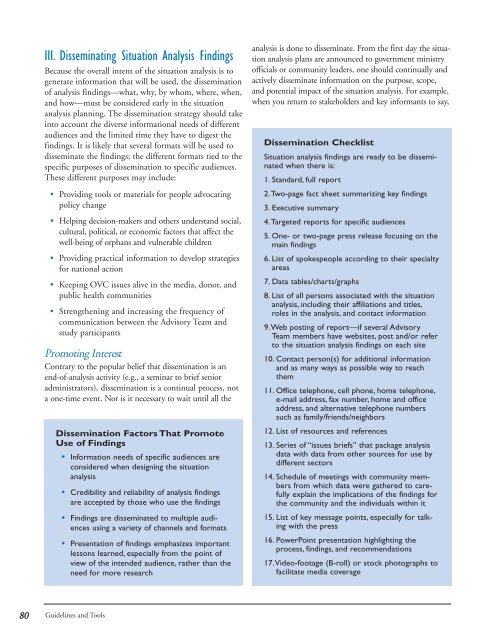Conducting a Participatory Situation Analysis of.pdf - Global HIV ...
Conducting a Participatory Situation Analysis of.pdf - Global HIV ...
Conducting a Participatory Situation Analysis of.pdf - Global HIV ...
You also want an ePaper? Increase the reach of your titles
YUMPU automatically turns print PDFs into web optimized ePapers that Google loves.
III. Disseminating <strong>Situation</strong> <strong>Analysis</strong> Findings<br />
Because the overall intent <strong>of</strong> the situation analysis is to<br />
generate information that will be used, the dissemination<br />
<strong>of</strong> analysis findings—what, why, by whom, where, when,<br />
and how—must be considered early in the situation<br />
analysis planning. The dissemination strategy should take<br />
into account the diverse informational needs <strong>of</strong> different<br />
audiences and the limited time they have to digest the<br />
findings. It is likely that several formats will be used to<br />
disseminate the findings; the different formats tied to the<br />
specific purposes <strong>of</strong> dissemination to specific audiences.<br />
These different purposes may include:<br />
• Providing tools or materials for people advocating<br />
policy change<br />
• Helping decision-makers and others understand social,<br />
cultural, political, or economic factors that affect the<br />
well-being <strong>of</strong> orphans and vulnerable children<br />
• Providing practical information to develop strategies<br />
for national action<br />
• Keeping OVC issues alive in the media, donor, and<br />
public health communities<br />
• Strengthening and increasing the frequency <strong>of</strong><br />
communication between the Advisory Team and<br />
study participants<br />
Promoting Interest<br />
Contrary to the popular belief that dissemination is an<br />
end-<strong>of</strong>-analysis activity (e.g., a seminar to brief senior<br />
administrators), dissemination is a continual process, not<br />
a one-time event. Nor is it necessary to wait until all the<br />
Dissemination Factors That Promote<br />
Use <strong>of</strong> Findings<br />
• Information needs <strong>of</strong> specific audiences are<br />
considered when designing the situation<br />
analysis<br />
• Credibility and reliability <strong>of</strong> analysis findings<br />
are accepted by those who use the findings<br />
• Findings are disseminated to multiple audiences<br />
using a variety <strong>of</strong> channels and formats<br />
• Presentation <strong>of</strong> findings emphasizes important<br />
lessons learned, especially from the point <strong>of</strong><br />
view <strong>of</strong> the intended audience, rather than the<br />
need for more research<br />
analysis is done to disseminate. From the first day the situation<br />
analysis plans are announced to government ministry<br />
<strong>of</strong>ficials or community leaders, one should continually and<br />
actively disseminate information on the purpose, scope,<br />
and potential impact <strong>of</strong> the situation analysis. For example,<br />
when you return to stakeholders and key informants to say,<br />
Dissemination Checklist<br />
<strong>Situation</strong> analysis findings are ready to be disseminated<br />
when there is:<br />
1. Standard, full report<br />
2.Two-page fact sheet summarizing key findings<br />
3. Executive summary<br />
4.Targeted reports for specific audiences<br />
5. One- or two-page press release focusing on the<br />
main findings<br />
6. List <strong>of</strong> spokespeople according to their specialty<br />
areas<br />
7. Data tables/charts/graphs<br />
8. List <strong>of</strong> all persons associated with the situation<br />
analysis, including their affiliations and titles,<br />
roles in the analysis, and contact information<br />
9.Web posting <strong>of</strong> report—if several Advisory<br />
Team members have websites, post and/or refer<br />
to the situation analysis findings on each site<br />
10. Contact person(s) for additional information<br />
and as many ways as possible way to reach<br />
them<br />
11. Office telephone, cell phone, home telephone,<br />
e-mail address, fax number, home and <strong>of</strong>fice<br />
address, and alternative telephone numbers<br />
such as family/friends/neighbors<br />
12. List <strong>of</strong> resources and references<br />
13. Series <strong>of</strong> “issues briefs” that package analysis<br />
data with data from other sources for use by<br />
different sectors<br />
14. Schedule <strong>of</strong> meetings with community members<br />
from which data were gathered to carefully<br />
explain the implications <strong>of</strong> the findings for<br />
the community and the individuals within it<br />
15. List <strong>of</strong> key message points, especially for talking<br />
with the press<br />
16. PowerPoint presentation highlighting the<br />
process, findings, and recommendations<br />
17.Video-footage (B-roll) or stock photographs to<br />
facilitate media coverage<br />
80<br />
Guidelines and Tools















